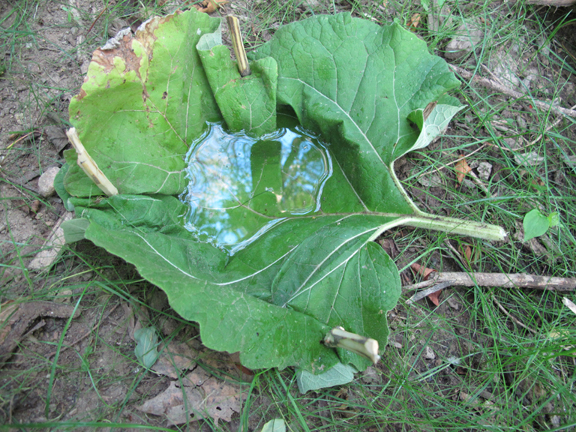The following info is far more interesting than I expected. There are far more things you could do with leaves than you probably know. You can make a bandage like the image above, or shingles, or food wrap, or even insoles. Certainly, where you are geographically and the kind of leaves available to you probably makes an impact, but make sure you read the article thoroughly and learn which situations you can improvise with whatever is available:
LEAF HACK # 1: ROPE
You can make usable cordage from leaves! The leaves you’ll want for this particular task are fibrous ones such as those from Yucca or Cattail. Yucca and cattail leaves work best but they’ll work when green in a pinch. Below is a photo of a Yucca plant and then also a coil of yucca leaf rope that I made.
The technique used to fashion usable cordage from fibrous natural materials is called the Reverse Wrap. It’s an awesome survival skill – so cool that I filmed a short video to show you exactly how to do it. Watch the video below:
LEAF HACK # 2: NATURE’S TIN FOIL
Have you ever wrapped food in tin foil and cooked it in the coals of a fire. Food wrapped in three layers of burdock leaves cooks just as good as any tin foil. By the way the leaves of burdock can get huge!
LEAF HACK # 3: INSOLES
That’s right – SHOE INSOLES! Need some extra cushion to help prevent blisters? How about some extra cushion that is also antibacterial? Look for a mullein plant. It’s very distinct, you can’t miss it. The leaves are thick, durable and fuzzy.
Not only do they make excellent improvised shoe insoles that will reduce foot odor but they also are your go-to natural source for toilet paper. They are also an excellent substitute for paper towel and are very absorptive. I use them as napkins all the time.
LEAF HACK # 4: INSULATION
Whether from the cold ground or the air around you, leaves are nature’s perfect insulative material for creating dead air space below and around you. One of the most effective cold weather shelters is a Debris Hut and it’s made almost entirely of leaves. The leaves capture dead air space which acts as a barrier to the cold. They help keep warm air (body heat) in and cold air out. As the cool temps come, Mother Nature drops all the insulation you could ever need to the forest floor. She’s nice that way.
LEAF SURVIVAL HACK # 5: SHINGLES
Yes, leaves are not only insulation but shingles as well. Large leaves from plants like burdock and skunk cabbage can be used to shingle a lean-to in a matter of minutes. Leafy branches can be used the same way. Remember to start from the bottom and work your way up, just like you would shingle a house. This overlapping pattern prevents rain from seeping through. Below I used a full burdock plant to protect jerky on a drying rack from a light drizzle.
LEAF HACK # 6: HARVESTING WATER
With a little creativity, you can use leaves to direct and harvest water. Rain water is the easiest form of fresh drinking water in the wild if you can get enough of it. Arranging leaves to harvest rain can gather exponentially more if you do it right. Look at them as nature’s little mini-tarps.
LEAF HACK # 7: KITCHEN WARE
From plates to bowls, leaves can be repurposed in all types of different functional ways. You can use basswood leaves for plates and napkins anytime. They’re edible, durable and environmentally safe! Below is a shot of a basswood leaf for reference:
The burdock leaf below is lining a hole in the ground and makes an excellent quickie bowl.
LEAF HACK # 8: MEDICATED BANDAGES
You’ve probably got plantain growing in your back yard right now. Did you know it has built in antibacterial and anti-inflammatory properties and is the perfect remedy for minor cuts, bee stings, stinging nettle and scrapes? Just chew up a leaf, place it on the wound and use another plantain leave to hold it in place. Plantain has earned the nickname “BANDAID PLANT” for a reason. The fibers in the leaves make durable bandages.
LEAF HACK # 9: DISTILLED WATER
Leaves transpire water all day long – called transpiration. It is possible to magnify and capture that water transpiration using clear plastic. Nonpoisonous vegetation placed in a ground pit solar still or live leaves tied off in a clear plastic bag can put out a surprising amount of water in full sun. It’s not the fastest and most efficient way of getting water but it’s an option nonetheless.
LEAF HACK # 10: FIRE TINDER
Dry leaves make excellent fire tinder and have constituted many a tinder bundle for me over the years. Some dried leaves, such as from the sage plant, smolder very well and can be used to carry an ember across long distances.
LEAF HACK # 11: MATS, WALLS, BASKETS, DOORS and ROOFING
Leaves from a variety of plants can be woven into about anything you can image, from baskets to shelter walls. Cattail leaves were used extensively by Native American Indians as a universal weaving material.
Cattail leaves were also used to weave hats, shoes, clothing, chair seats, fishing nets, duck decoys and children’s toys. It is an amazingly durable weaving material.
LEAF HACK # 12: FOOD
I can’t even list all of the wild plant leaves that are edible.
Here is the full article from the source: 12 Survival Hacks Using Just Leaves















